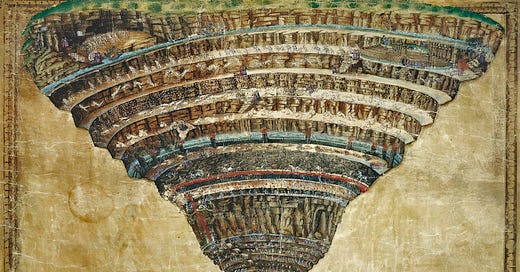The Abyss of Hell, Sandro Botticelli, ca 1480
In the writings of mathematician Alexander Grothendieck, there is a recurring discussion of two opposing strategies when confronting problems. One strategy, which he saw as the default among mathematicians and lamented leaning on early in his career, was to “attack problems,” that is, directly work to prove what you have set out to prove. This is how I did math when I was younger. Handed a problem, I would attempt the first thing that came to mind; if that failed I would go for another approach—trying increasingly thoughtless tactics until the problem, through sheer force, cracked open. Then I would move on.
The other approach, which Grothendieck preferred, he famously illustrated with a metaphor of a rising sea:
The unknown thing to be known appeared to me as some stretch of earth or hard marl, resisting penetration… the sea advances insensibly in silence, nothing seems to happen, nothing moves, the water is so far off you hardly hear it.. yet it finally surrounds the resistant substance.
Practically speaking, what he did was explore the problem in an open-ended way, building intuition, introducing notation—growing an entire theory around the problem. This could go on for years. Until one day, the solution had become self-evident, a natural consequence of the theory. The problem essentially disappeared. It had been swallowed by the sea.
These ways of working on problems, going fast or slow, can be seen in all domains. Some writers go as fast as they can type, others take years understanding the world they will describe. Some house owners plant their gardens with whatever flowers catch their fancy at the store, others study the soil, the local fauna, the way the sun moves through the day . . .
There is an obvious drawback to going deep: the solutions may take a long time to surface. Grothendieck was famous for his willingness to spend a long time on a problem. He was insanely productive (averaging the equivalent of one paper a day for twelve years!) but often what he chose to work on was not ideal from the perspective of an academic career. He wasn’t optimizing for short term wins. He wouldn’t write up proofs to important theorems if he felt like he didn’t understand it properly, or if he felt that it could wait until its proper place in the larger theory had been reached. Sometimes, after years of waiting, his theorems would have to be written up and published by others, such as when Borel and Serre wrote up his proof of the Grothendieck-Riemann-Roch theorem.
So going deep is, to some extent, a luxury you can gift yourself if you have time.
Yet, when I look at the most effective people I know, they all have core areas where they are willing to invest the time to go this deep.
And inversely, the typical approach that I see when I have to sit in on meetings, where people settle on the first solution that comes to mind without investigating their understanding of the problem—this rarely ends well.
Problems are typically richer than our preconceived notions about how to solve them. We can learn this the hard way, by failing and then failing again but failing better. But there are often shortcuts to be found if you are willing to spend more time mapping the landscape.
But what is it that happens in the mind of someone who lingers longer on a problem?
Michael Nielsen writes about this in an essay where he describes the experience of pushing himself to go deeper than usual in understanding a mathematical proof:
I gradually internalize the mathematical objects I’m dealing with [using spaced repetition]. It becomes easier and easier to conduct (most of) my work in my head. [. . .] Furthermore, as my understanding of the objects change – as I learn more about their nature, and correct my own misconceptions – my sense of what I can do with the objects changes as well. It’s as though they sprout new affordances, in the language of user interface design, and I get much practice in learning to fluidly apply those affordances in multiple ways. [. . .]
After going through the [time-consuming process of deeply understanding a proof,] I had a rather curious experience. I went for a multi-hour walk along the San Francisco Embarcadero. I found that my mind simply and naturally began discovering other facts related to the result. In particular, I found a handful (perhaps half a dozen) of different proofs of the basic theorem, as well as noticing many related ideas. This wasn’t done especially consciously – rather, my mind simply wanted to find these proofs.
When you go deep, probing the assumptions, looking from multiple angles, and reformulating things in your own words, the ideas become part of you. This is one of the reasons why I write. When I unpack things fully, the ideas become objects that I can rotate in my mind. The subconscious can draw parallels that it can’t if the ideas haven’t been thoroughly unpacked.
There is a line from Oscar Wilde that gets at this, when he says that to write well, all you need to do is develop your mind and then write what you see. If you have thought deeply, nearly everything looks interesting.
This phase shift, when ideas and concepts start behaving in new ways in our minds after they have been deeply understood, is, I assume, part of the explanation why Grothendieck was able to produce such astounding amounts of mathematics while feeling there was almost no effort involved. It was simply obvious to him, he just had to write it down. He had been so immersed in mathematics, contemplating it nearly every waking hour for decades—so his mind sprouted the most surprising and revolutionary affordances.
Warmly,
Henrik






Love this; embodying problems, allowing them to penetrate your psyche, the rhythm of your steps when walking, and trusting that you will be able to sit with them and then exorcise them, procures the solution
Astounding is exactly the word! He must have been able to keep quite a lot in his mind to publish a paper a day for over a decade! Or is it that his deep and broad understanding in each occupied field sprouted —indeed, effortlessly— many papers from the same ground, as it were?